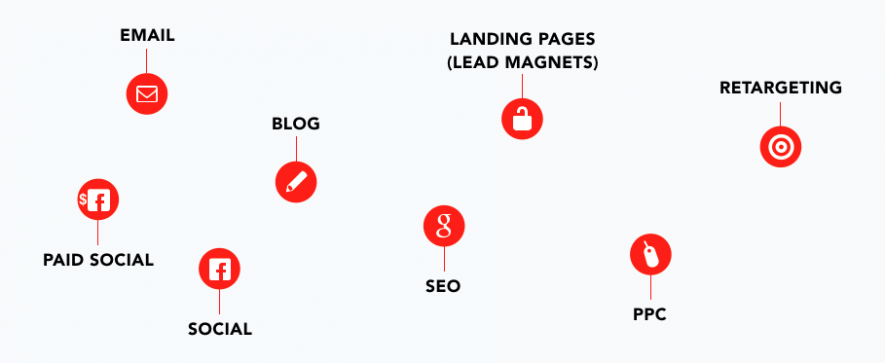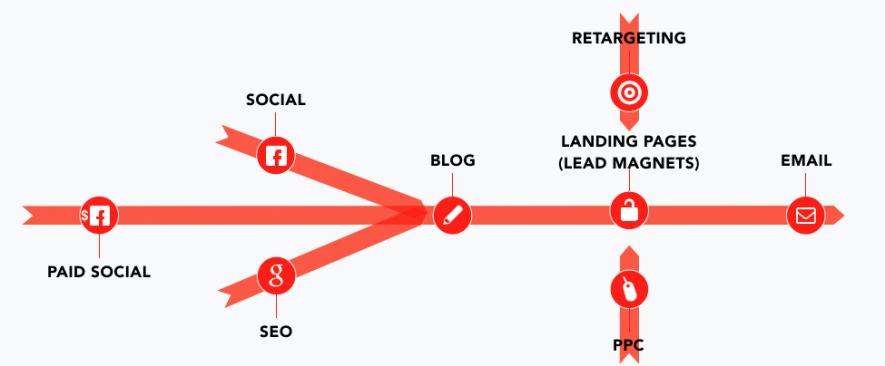Frank Cowell Leads to Customers: An Automated Approach to a Humanized Smarketing Funnel 39 Wow-Score The Wow-Score shows how engaging a blog post is. It is calculated based on the correlation between users’ active reading time, their scrolling speed and the article’s length. Learn more Leads to Customers: An Automated Approach to a Humanized Smarketing Funnel
- 70
- 16
- 5
- 5
You are generating Leads. Now What?
Before I just simply give you the answer, let me back-up a moment…
The goal of inbound marketing is to generate highly qualified leads for sales to close. Contrary to popular belief, lead generation is only the tip of the proverbial inbound marketing iceberg. Successful inbound marketing programs go beyond landing pages and calls-to-action — they employ a marketing and sales funnel, also known as a “Smarketing Funnel”.
I must say, lead generation isn’t always easy. But, it can be done with the right tools and, more importantly, the right approach. Now, if you’re already generating leads, congratulations, you’ve completed one of the first steps of an effective Smarketing funnel!
To begin, it is important to remember that your new lead is a real-life, living, breathing human being. Once you receive their information, it is easy to get excited. But, it is important to take “small steps”… kind of like “dating.” In fact, you can think of your lead in terms of a new romantic relationship.
A Relationship That Follows a Natural Order of Events
When you meet someone, there is a series of natural, logical events. Typically, it goes like this:
1) There is mutual interest and information is exchanged
2) There is a casual encounter, possibly a coffee date
3) Things progress and “get serious”
4) There is a proposal
5) Then, there is the “final contract”
Similar to the “courtship” described above, a Smarketing funnel follows the same natural order of events of real-life relationships.
Yet, marketing and sales teams often get eager and move too quickly with new leads. Instead of enticing your leads with a natural cadence of enriching information, you “propose” or make an offer for your core product within your initial email contact.
How would you feel if you met someone and they asked you to marry them right after giving them your phone number? You would probably be a little creeped out and move on.
As you architect your Smarketing funnel, it is critical to remember that small commitments lead to big commitments. I will speak to the small commitments later on in this article, but before I get to those, it’s essential we first dial in the roles of your marketing and sales teams.
Know Where Marketing Ends and Sales Begins
In a perfect world, marketing and sales teams would first define their roles before they start generating leads. For instance, “marketing” ends and “sales” begins when [fill in the blank]. The parameters that define when marketing ends and sales begins is different for each company. No matter where it ends or begins, it is important that both teams understand their role and when the lead shifts from the marketing team to sales.
In addition to defining the parameters of the lead “hand-off”, it is essential that marketing and sales teams set goals and mutually align on why and how the goals will be achieved. As these goals are decided, it is necessary to calculate the maximum acceptable acquisition cost. The best question you can ask when calculating the maximum acceptable acquisition cost is: “What is the MOST I can spend?”.
Once your goals are in place, you know your acquisition budget, and your marketing and sales teams’ roles have been defined, you are ready to build out a Smarketing funnel that systematically, logically, and naturally turns leads into customers.
First, let’s review the difference between sales and marketing funnels.
Traditional VS Ideal Sales Funnels
Traditionally, sales funnels look like this:

How often do you present your lead with your core opportunity after inviting them to coffee? If you answered “often”, don’t worry, you are not alone. A lot of marketing and sales teams jump into their “big commitment” offer and skip the “small commitment” offers that were previously mentioned above.
“Small Commitments” are the elements that shift traditional sales funnels into ideal machines that convert leads to customers. The ideal sales funnel includes small commitments that deliver specific value:

Traditional sales funnels jump from prospecting to coffee to the core opportunity. An ideal sales funnel includes smaller commitments, known as “tripwires”, to create a flow of events that correspond to real-life relationships. Tripwires are no-cost to low-cost offers that require an investment of time and energy from your leads and most importantly, they deliver value to your lead before you introduce your core opportunity.
Tripwires are effective because your leads have already “bought in” before you introduce them to your core opportunity. They have already put in time and they have received value from your organization — they trust you and they are ready to be “sold”.
I know what you are thinking: “My company doesn’t have a tripwire!”… And, in spite of what you may think, I guarantee you do. Tripwires are easily crafted by splintering off pieces of your core offering, or by “productizing” a component of your sales process.
For example, in my business, I was able to “productize” a portion of our sales process where we were spending lots of time developing rich, robust inbound marketing plans. We standardized it, added more value to it and lo-and-behold, we had something that was worth paying for! In fact, in true tripwire fashion, we way undercharge for it to ensure that clients receive way more value than what they spend.
Typical VS Ideal Marketing Funnels
In order to get leads into your ideal sales funnel, you first need to create an ideal marketing funnel. Traditional marketing funnels tend to look something like this:

In short, there is no funnel. Typical marketing “funnels” tend to be siloed marketing efforts that act independently from one another. I know what you are thinking now, “What does an ideal marketing funnel look like then?”
An ideal marketing funnel is based on content that is relevant and provides specific value:

As with all inbound marketing activities, you want to provide value to your leads at every touchpoint. In the ideal marketing funnel, your efforts are specific, coordinated, and targeted — your leads will unconsciously recognize your efforts and willingly move themselves from “stranger” to “lead” through enjoying your valuable content.
If you are able to provide value to your lead, they are much more likely to move along their buyer’s journey with less resistance and with more interest in your product or service.
The Ideal “Smarketing” Funnel
If you thought the Ideal Sales Funnel and the Ideal Marketing Funnel were great, get ready to meet the Ideal “Smarketing” Funnel…
In the ideal “Smarketing” funnel, marketing and sales align to deliver specific value:

Within the “Smarketing” funnel, marketing activities work to deliberately target and attract the exact type of lead the sales team wants. These funnels may seem theoretical, but they work like a science!
Are you interested in seeing an example and learning how marketing automation can help you amplify your results?
Join SEMrush and me for a FREE Webinar:
Beyond the Landing Page: How to Systematically Turn Web Leads into Customers, on Tuesday, April 18th at 2PM ET. During the webinar, I will deconstruct the funnels you read about in this article and provide examples of how to systematically engage your leads through automation as you turn them into customers!
To register, click here.



